Abstract
The National Committee for Clinical Laboratory Standards agar dilution method was used to compare the in vitro activity of WY-49605 (also called SUN/SY 5555 and ALP-201), a new broad-spectrum oral penem, to those of amoxicillin, amoxicillin-clavulanate, imipenem, ciprofloxacin, cefaclor, cefpodoxime, cefuroxime, clindamycin, and metronidazole against 384 clinically isolated anaerobes. These anaerobic organisms included 90 strains from the Bacteroides fragilis group, 87 Prevotella and Porphyromonas strains, non-B. fragilis group Bacteroides strains, 56 fusobacteria, 55 peptostreptococci, 49 gram-positive non-spore-forming rods, and 47 clostridia. Overall, WY-49605 had an MIC range of 0.015 to 8.0 micrograms/ml, an MIC at which 50% of the isolates are inhibited (MIC50) of 0.25 microgram/ml, and an MIC at which 90% of the isolates are inhibited (MIC90) of 2.0 micrograms/ml. Good activity against all anaerobe groups was observed, except for Clostridium difficile and lactobacilli (MIC50s of 4.0 and 2.0 micrograms/ml, respectively, and MIC90s of 8.0 and 2.0 micrograms/ml, respectively). Imipenem had an MIC50 of 0.03 microgram/ml and an MIC90 of 0.25 microgram/ml. Ciprofloxacin was much less active (MIC50 of 2.0 micrograms/ml and MIC90 of 16.0 micrograms/ml). By comparison, all oral beta-lactams were less active than WY-49605, with susceptibilities as follows: amoxicillin MIC50 of 8.0 micrograms/ml and MIC90 of > 256.0 micrograms/ml), amoxicillin-clavulanate MIC50 of 1.0 microgram/ml and MIC90 of 8.0 micrograms/ml, cefaclor MIC50 of 8.0 micrograms/ml and MIC90 of > 32.0 micrograms/ml, cefpodoxime MIC50 of 4.0 micrograms/ml and MIC90 of > 32.0 micrograms/ml, and cefuroxime MIC50 of 4.0 micrograms/ml and MIC90 of > 32.0 micrograms/ml. Clindamycin was active against all groups except some members of the B. fragilis group, Fusobacterium varium, and some clostridia ( overall MIC50 of 0.5 micrograms/ml and overall MIC90 of 8.0 micrograms/ml). Metronidazole was active (MIC of less than or equal to 4.0 micrograms/ml) against all gram-negative anaerobic rods, but most gram-positive non-spore-forming rods, some peptostreptococci, and some clostridia were less susceptible. To date, WY-49605 is the most active oral beta-lactam against anaerobes: these results suggest clinical evaluation for clinical indications suitable for oral therapy.
Full text
PDF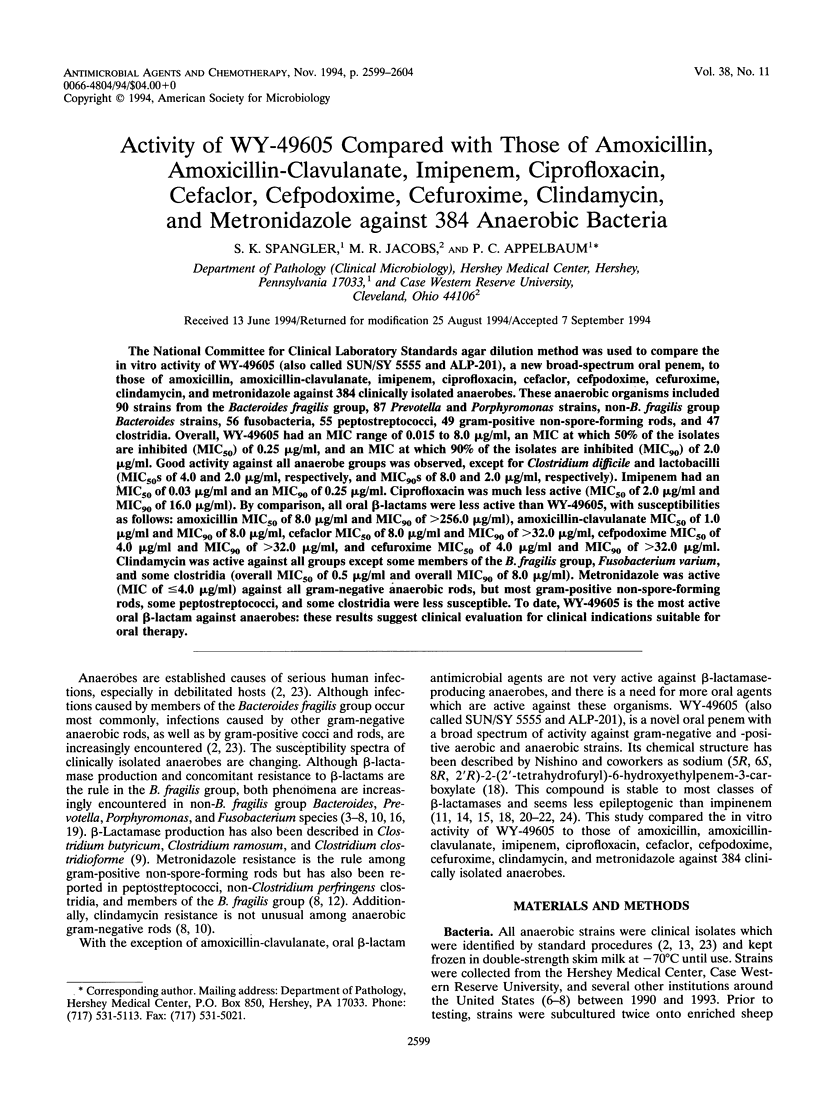
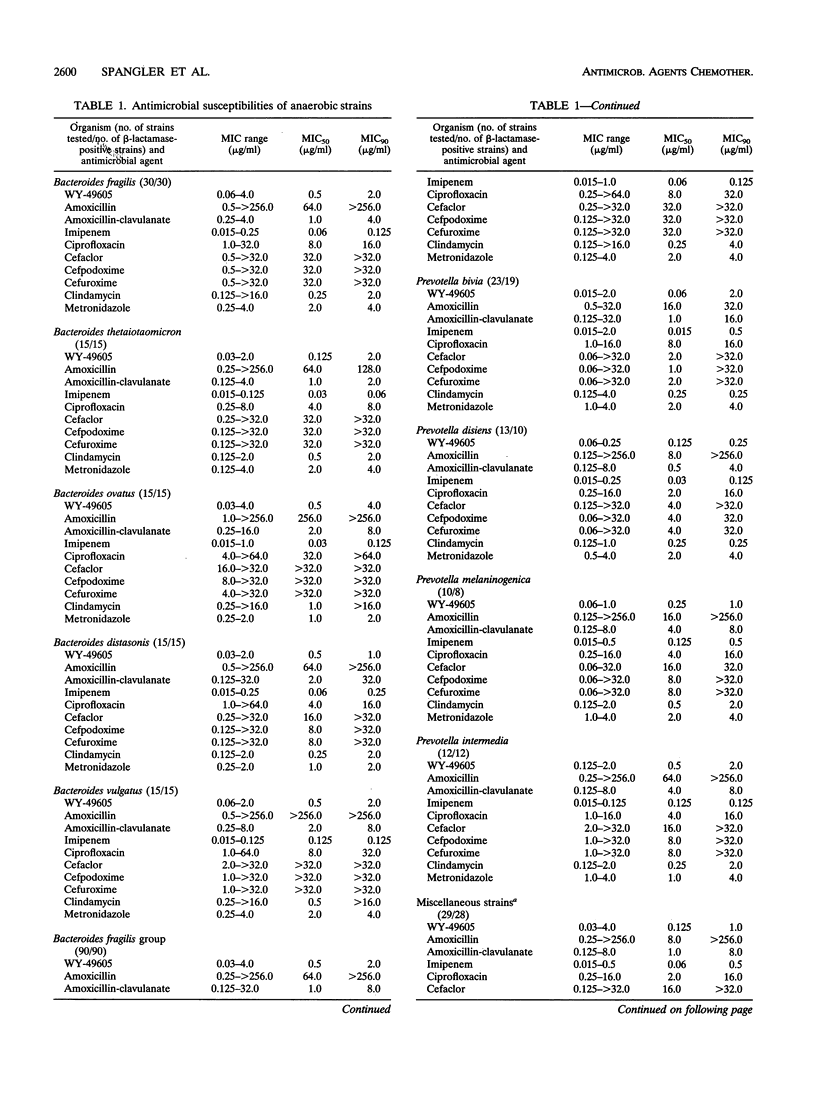
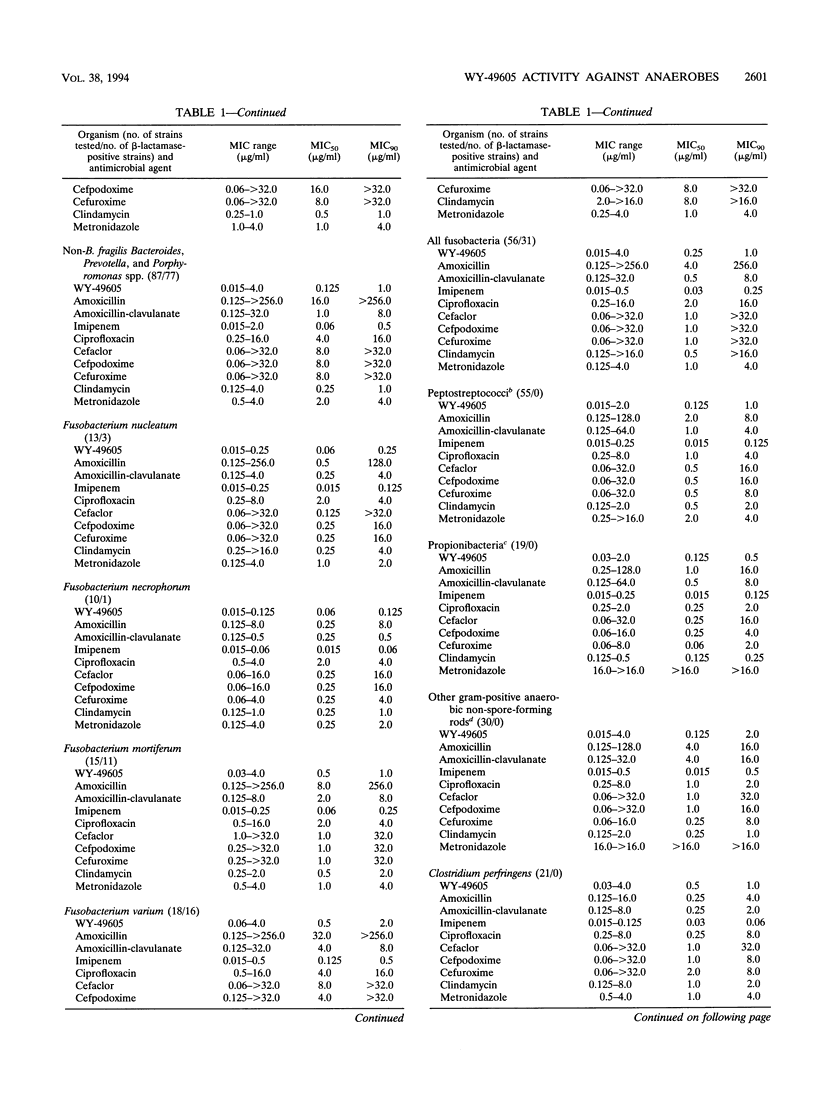
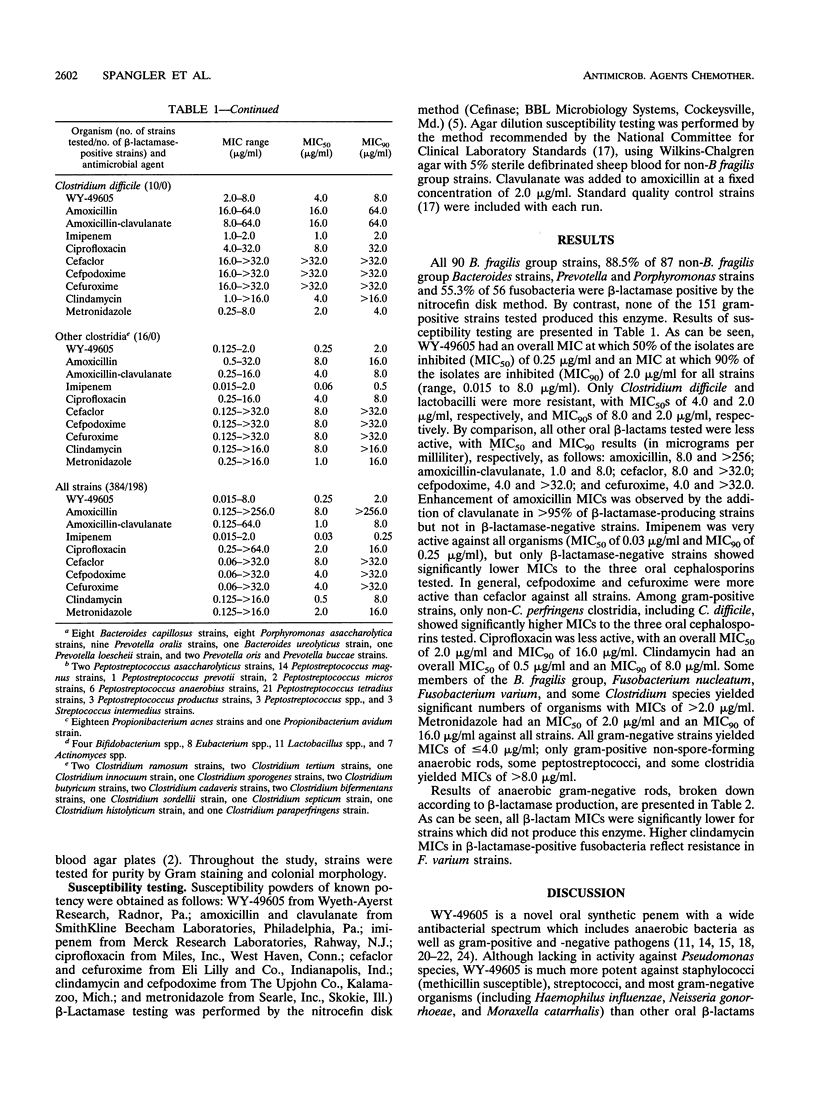
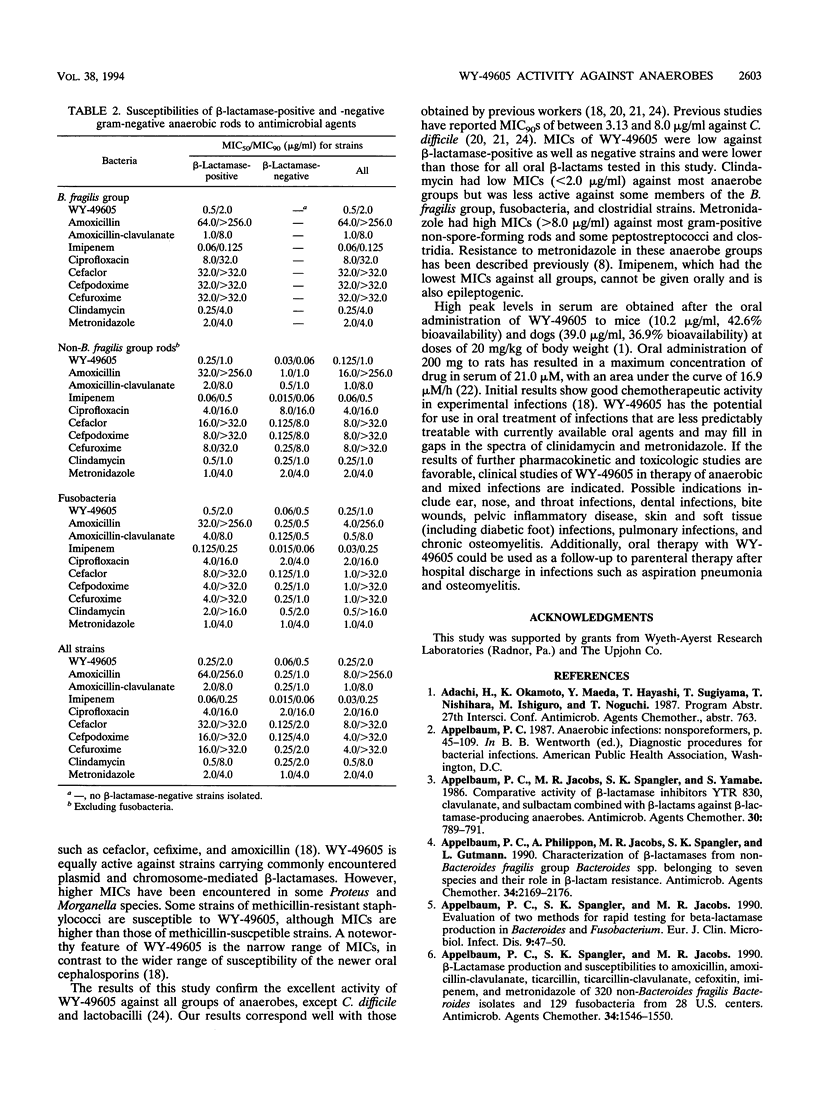
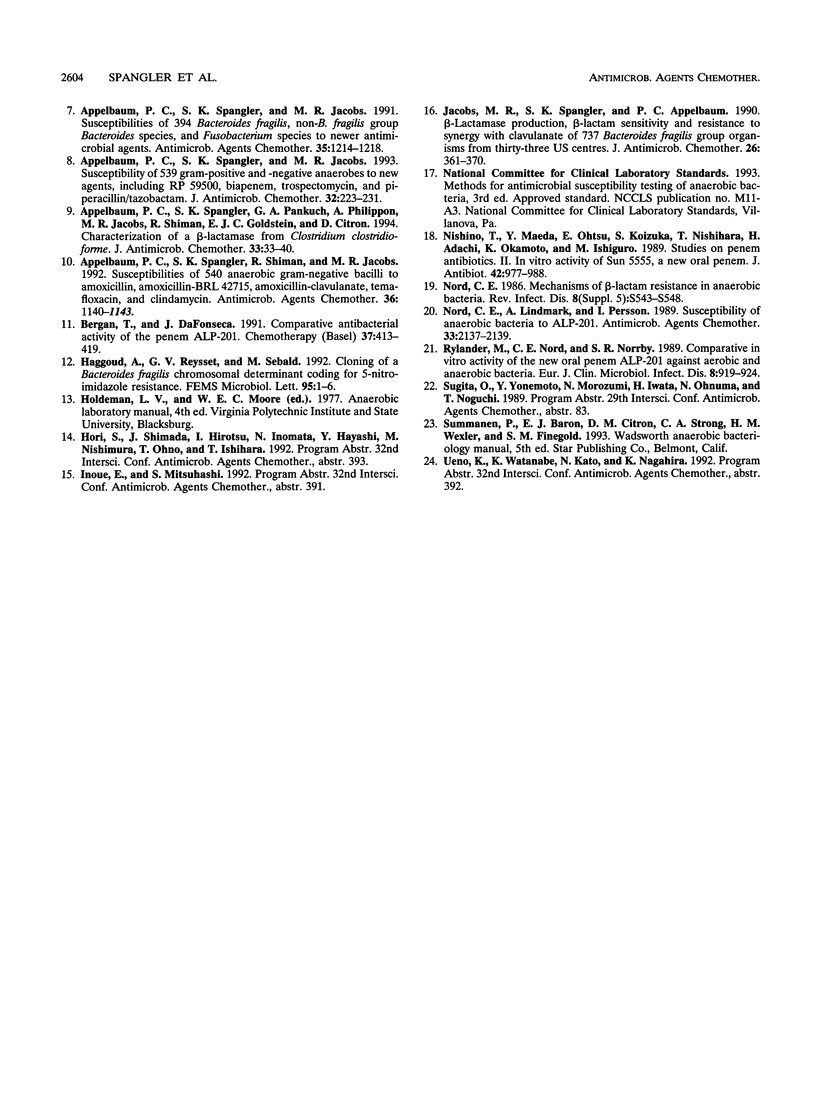
Selected References
These references are in PubMed. This may not be the complete list of references from this article.
- Appelbaum P. C., Jacobs M. R., Spangler S. K., Yamabe S. Comparative activity of beta-lactamase inhibitors YTR 830, clavulanate, and sulbactam combined with beta-lactams against beta-lactamase-producing anaerobes. Antimicrob Agents Chemother. 1986 Nov;30(5):789–791. doi: 10.1128/aac.30.5.789. [DOI] [PMC free article] [PubMed] [Google Scholar]
- Appelbaum P. C., Philippon A., Jacobs M. R., Spangler S. K., Gutmann L. Characterization of beta-lactamases from non-Bacteroides fragilis group Bacteroides spp. belonging to seven species and their role in beta-lactam resistance. Antimicrob Agents Chemother. 1990 Nov;34(11):2169–2176. doi: 10.1128/aac.34.11.2169. [DOI] [PMC free article] [PubMed] [Google Scholar]
- Appelbaum P. C., Spangler S. K., Jacobs M. R. Beta-lactamase production and susceptibilities to amoxicillin, amoxicillin-clavulanate, ticarcillin, ticarcillin-clavulanate, cefoxitin, imipenem, and metronidazole of 320 non-Bacteroides fragilis Bacteroides isolates and 129 fusobacteria from 28 U.S. centers. Antimicrob Agents Chemother. 1990 Aug;34(8):1546–1550. doi: 10.1128/aac.34.8.1546. [DOI] [PMC free article] [PubMed] [Google Scholar]
- Appelbaum P. C., Spangler S. K., Jacobs M. R. Evaluation of two methods for rapid testing for beta-lactamase production in Bacteroides and Fusobacterium. Eur J Clin Microbiol Infect Dis. 1990 Jan;9(1):47–50. doi: 10.1007/BF01969535. [DOI] [PubMed] [Google Scholar]
- Appelbaum P. C., Spangler S. K., Jacobs M. R. Susceptibilities of 394 Bacteroides fragilis, non-B. fragilis group Bacteroides species, and Fusobacterium species to newer antimicrobial agents. Antimicrob Agents Chemother. 1991 Jun;35(6):1214–1218. doi: 10.1128/aac.35.6.1214. [DOI] [PMC free article] [PubMed] [Google Scholar]
- Appelbaum P. C., Spangler S. K., Jacobs M. R. Susceptibility of 539 gram-positive and gram-negative anaerobes to new agents, including RP59500, biapenem, trospectomycin and piperacillin/tazobactam. J Antimicrob Chemother. 1993 Aug;32(2):223–231. doi: 10.1093/jac/32.2.223. [DOI] [PubMed] [Google Scholar]
- Appelbaum P. C., Spangler S. K., Pankuch G. A., Philippon A., Jacobs M. R., Shiman R., Goldstein E. J., Citron D. M. Characterization of a beta-lactamase from Clostridium clostridioforme. J Antimicrob Chemother. 1994 Jan;33(1):33–40. doi: 10.1093/jac/33.1.33. [DOI] [PubMed] [Google Scholar]
- Appelbaum P. C., Spangler S. K., Shiman R., Jacobs M. R. Susceptibilities of 540 anaerobic gram-negative bacilli to amoxicillin, amoxicillin-BRL 42715, amoxicillin-clavulanate, temafloxacin, and clindamycin. Antimicrob Agents Chemother. 1992 May;36(5):1140–1143. doi: 10.1128/aac.36.5.1140. [DOI] [PMC free article] [PubMed] [Google Scholar]
- Bergan T., da Fonseca J. Comparative antibacterial activity of the penem ALP 201. Chemotherapy. 1991;37(6):413–419. doi: 10.1159/000238888. [DOI] [PubMed] [Google Scholar]
- Haggoud A., Reysset G., Sebald M. Cloning of a Bacteroides fragilis chromosomal determinant coding for 5-nitroimidazole resistance. FEMS Microbiol Lett. 1992 Aug 1;74(1):1–5. doi: 10.1016/0378-1097(92)90728-7. [DOI] [PubMed] [Google Scholar]
- Jacobs M. R., Spangler S. K., Appelbaum P. C. Beta-lactamase production, beta-lactam sensitivity and resistance to synergy with clavulanate of 737 Bacteroides fragilis group organisms from thirty-three US centres. J Antimicrob Chemother. 1990 Sep;26(3):361–370. doi: 10.1093/jac/26.3.361. [DOI] [PubMed] [Google Scholar]
- Nishino T., Maeda Y., Ohtsu E., Koizuka S., Nishihara T., Adachi H., Okamoto K., Ishiguro M. Studies on penem antibiotics. II. In vitro activity of SUN5555, a new oral penem. J Antibiot (Tokyo) 1989 Jun;42(6):977–988. doi: 10.7164/antibiotics.42.977. [DOI] [PubMed] [Google Scholar]
- Nord C. E., Lindmark A., Persson I. Susceptibility of anaerobic bacteria to ALP 201. Antimicrob Agents Chemother. 1989 Dec;33(12):2137–2139. doi: 10.1128/aac.33.12.2137. [DOI] [PMC free article] [PubMed] [Google Scholar]
- Nord C. E. Mechanisms of beta-lactam resistance in anaerobic bacteria. Rev Infect Dis. 1986 Nov-Dec;8 (Suppl 5):S543–S548. doi: 10.1093/clinids/8.supplement_5.s543. [DOI] [PubMed] [Google Scholar]
- Rylander M., Nord C. E., Norrby S. R. Comparative in vitro activity of the new oral penem ALP-201 against aerobic and anaerobic bacteria. Eur J Clin Microbiol Infect Dis. 1989 Oct;8(10):919–924. doi: 10.1007/BF01963784. [DOI] [PubMed] [Google Scholar]


